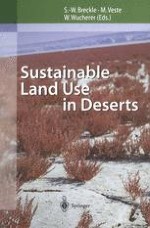2001 | OriginalPaper | Buchkapitel
Degradation of the Vegetation in the Central Kyzylkum Desert (Uzbekistan)
verfasst von : Lyuba Kapustina
Erschienen in: Sustainable Land Use in Deserts
Verlag: Springer Berlin Heidelberg
Enthalten in: Professional Book Archive
Aktivieren Sie unsere intelligente Suche, um passende Fachinhalte oder Patente zu finden.
Wählen Sie Textabschnitte aus um mit Künstlicher Intelligenz passenden Patente zu finden. powered by
Markieren Sie Textabschnitte, um KI-gestützt weitere passende Inhalte zu finden. powered by
The extent of degradation in the vegetation of the Kyzylkum Desert was determined by topography and GIS. Topography is an important variable in many ecological processes. GIS provides a number of methods for analyzing topography. The ability to analyze digital topographic data has significantly advanced ecological modelling (Johnston 1998). Geobotanic investigation, large-scale mapping and GIS make it possible to find conventionally climax associations and their anthopogenic modification in the Central Part of the Kyzylkum Desert. Zonal types were formed on the Old Xerophilous and Old Mediterrenean bases in the Paleogene and Neogene. The main types are Turanian semishrub desert type, Turanian psammophyton type, Irano—Turanian psammosavanna type and halophyton turanicum type on the different type of soils. Before the 20th century, climax associations of the first and second types were predominant in the plant cover. At present, associations of the third type predominate on sandy desert soils. Natural renewal of the fodder plants in intensively used pastures practically does not occur and weeds and unpalatable species predominate. Ninety percent of the degraded vegetation was determined by spatial analysis. Average dry mass of the pasture plants is about 105 kg ha−1 centner/hectare on grey-brown soils and 55 kg ha−1 on sandy desert soils.
